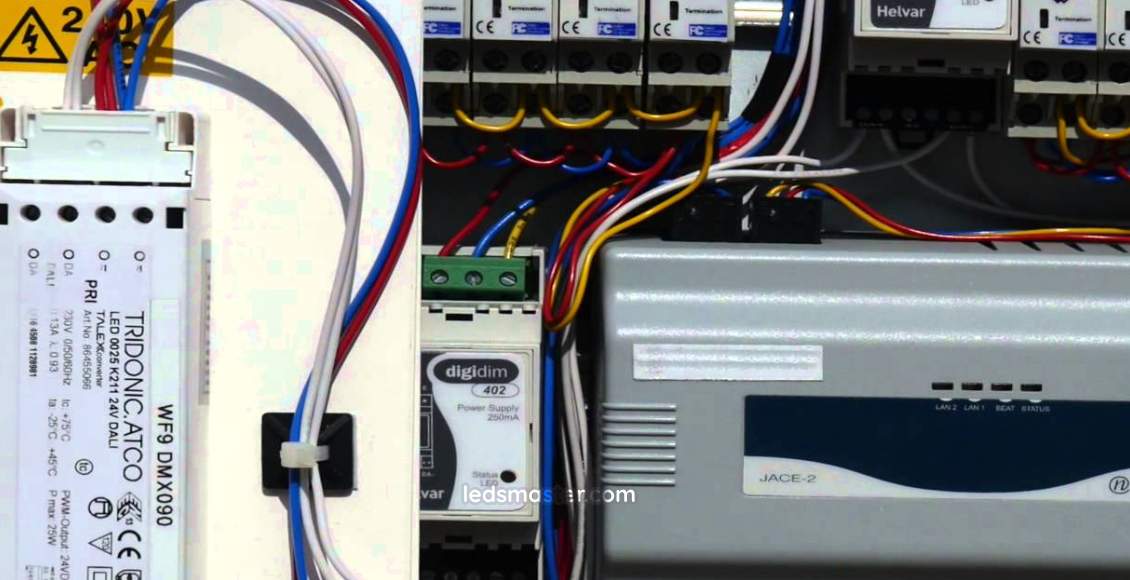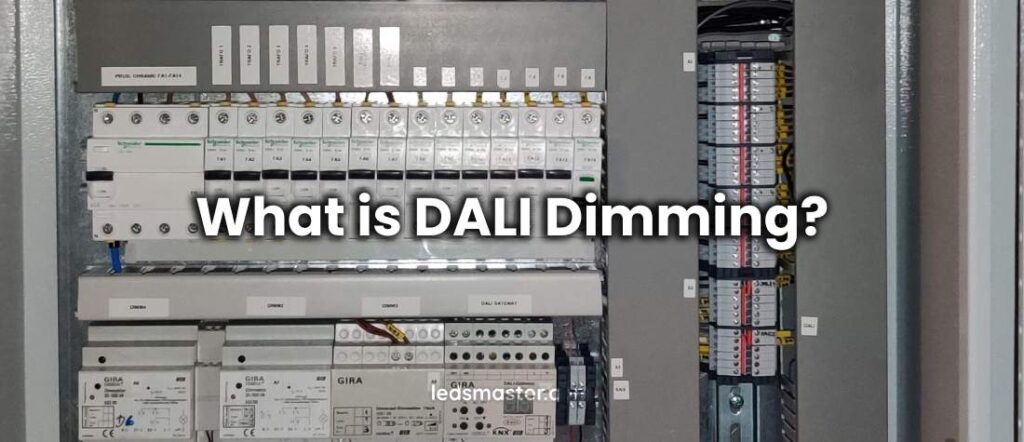DALI (Digital Addressable Lighting Interface) dimming represents a sophisticated lighting control protocol that is widely used in modern lighting systems, especially those involving LED technology. Developed to provide a more advanced and flexible approach to lighting control compared to traditional systems, DALI dimming has become a crucial component in creating intelligent and adaptive lighting environments. This article explores the fundamentals of DALI dimming, its operational principles, and its integration with LED lighting to illustrate its impact and advantages.
Table of Contents
ToggleDALI Dimming
The Basics of DALI
DALI, an acronym for Digital Addressable Lighting Interface, is an international standard for digital lighting control. It provides a means to control the brightness and behavior of lighting fixtures through a digital communication protocol. Unlike traditional dimming methods, which use analog signals, DALI operates through digital communication, allowing for precise and reliable control of lighting systems.
The DALI protocol is defined by the IEC 62386 standard, which outlines the technical specifications for digital lighting control. This standard ensures compatibility between different manufacturers’ products, allowing for a cohesive and interoperable lighting system. DALI systems can manage individual lighting fixtures or groups of fixtures, providing flexibility in how light is controlled and adjusted within a space.
How DALI Dimming Works
At the heart of DALI dimming is its digital communication system, which allows for detailed and accurate control over lighting. A typical DALI setup includes a central controller, DALI-compatible drivers, and the lighting fixtures themselves. The central controller sends digital commands to the drivers, which then adjust the light output of the fixtures based on the received signals.
The DALI protocol operates on a two-wire bus system, where both the power and communication signals are transmitted along the same pair of wires. This simplifies the wiring infrastructure and reduces installation complexity. The communication between the controller and drivers is conducted through a series of commands that instruct the fixtures to adjust their brightness, color temperature, or other attributes as needed.
DALI dimming allows for precise control over light levels, with the ability to adjust brightness in fine increments. This is achieved through digital signals that are sent to the drivers, which then modulate the power supplied to the LEDs or other light sources. The result is a smooth and flicker-free dimming experience that enhances visual comfort and adaptability in various lighting scenarios.

Integration with LED Lighting
The synergy between DALI dimming and LED lighting technology brings numerous advantages that enhance both the functionality and efficiency of lighting systems. As LEDs continue to revolutionize lighting with their energy efficiency and longevity, integrating them with DALI control systems further amplifies their benefits.
Precision and Smooth Dimming
One of the standout advantages of combining DALI dimming with LEDs is the ability to achieve precise and smooth dimming. LEDs respond quickly to variations in current, making them highly adaptable to different light levels. The digital nature of DALI enhances this capability by providing fine-tuned control over the brightness of LED fixtures. This precision is crucial in environments where specific lighting conditions are required, such as in offices where lighting can be adjusted to reduce eye strain or in retail settings where the lighting needs to highlight products effectively. The ability to make small, incremental adjustments ensures that the light output is always suited to the task at hand, enhancing both visual comfort and the overall atmosphere.
Enhanced Flexibility
Another significant benefit of DALI dimming when paired with LEDs is the enhanced flexibility it offers. DALI systems allow for the control of individual fixtures or groups of fixtures, enabling dynamic lighting configurations that can be easily adapted to changing needs. This flexibility is particularly valuable in spaces that require varied lighting scenarios throughout the day or for different events. For example, in a conference room, DALI dimming can adjust the lighting from bright and focused for presentations to softer and more ambient for discussions or breaks. Similarly, in hospitality venues such as restaurants or hotels, the ability to seamlessly transition between bright, energizing lighting during daytime hours and subdued, cozy lighting in the evening helps create the desired atmosphere for different times and occasions.
Improved Energy Efficiency
The integration of DALI dimming with LED technology also contributes to improved energy efficiency. LEDs are already known for their low energy consumption compared to traditional lighting sources, and DALI systems further enhance this benefit by allowing for precise control over light levels. By ensuring that lights are only as bright as needed for the specific task or setting, DALI helps to reduce unnecessary energy use. This capability is particularly beneficial in large-scale applications, such as commercial buildings or industrial facilities, where multiple fixtures are in use. Additionally, DALI systems support advanced features like daylight harvesting and occupancy sensing, which can further optimize energy savings by adjusting artificial lighting based on the availability of natural light and room occupancy.
Customizable Lighting Scenarios
The adaptability of DALI dimming allows for the creation of customizable lighting scenarios that can be tailored to various needs and preferences. This feature is particularly advantageous in environments that require different lighting settings for different activities. For instance, in a retail store, DALI dimming can be used to highlight specific displays or products, creating engaging and visually appealing presentations that enhance the shopping experience. In an office setting, customizable lighting scenarios can improve productivity and comfort by adjusting light levels based on the time of day or the specific tasks being performed.
Seamless Integration with Smart Systems
Finally, DALI dimming systems integrate well with smart home and building management systems, offering even greater control and automation. The ability to connect DALI dimming with other smart technologies allows for automated adjustments based on factors such as time of day, occupancy, or weather conditions. This seamless integration not only enhances the convenience and functionality of the lighting system but also contributes to overall energy efficiency and user comfort.
DALI for Lighting Control
DALI dimming also contributes to improved energy efficiency. By enabling precise control over light levels, DALI systems help to reduce energy consumption by ensuring that lights are only as bright as necessary for the task at hand. This energy savings is particularly relevant in large-scale applications where multiple fixtures are in use, such as in commercial buildings or industrial facilities.
Furthermore, DALI systems support advanced features such as daylight harvesting and occupancy sensing. Daylight harvesting involves adjusting artificial lighting based on the amount of natural light available, while occupancy sensors automatically adjust lighting based on room occupancy. Both of these features contribute to additional energy savings and enhanced lighting comfort.
Applications of DALI Dimming
Residential Lighting
DALI dimming revolutionizes residential lighting by offering homeowners precise control over their lighting environments. Unlike traditional systems, which often provide limited control, DALI allows for detailed adjustments to create specific lighting scenes for various activities. Whether it’s brightening up the living room for a social gathering or dimming it for a cozy evening, DALI enables seamless transitions between different settings, enhancing both comfort and ambiance. This flexibility also integrates well with smart home systems, enabling automated adjustments based on time of day, occupancy, or weather conditions, resulting in a more personalized and efficient living space.
Commercial and Office Lighting
For commercial and office environments, DALI dimming provides the ability to create dynamic and adaptable lighting setups. In office spaces, the ability to fine-tune lighting levels helps to improve productivity and reduce eye strain. Additionally, DALI systems can support automated lighting adjustments based on occupancy and natural light levels, further enhancing energy efficiency and user comfort.
Retail environments benefit from DALI dimming through its ability to highlight products and create engaging displays. The precise control offered by DALI allows for targeted lighting that can accentuate specific items or create attractive visual effects. This capability is essential for creating a compelling shopping experience and enhancing the overall appeal of merchandise.
Hospitality and Entertainment Venues
In hospitality settings such as hotels and restaurants, DALI dimming contributes to creating the desired atmosphere for different times of the day and various events. From bright, energizing lighting for morning breakfasts to soft, ambient lighting for evening dinners, DALI systems provide the flexibility needed to adjust lighting to match the mood and function of the space.
Entertainment venues, including theaters and concert halls, also benefit from DALI dimming. The ability to create precise lighting effects and transitions is crucial for setting the stage and enhancing the overall experience for audiences. DALI’s smooth and accurate control allows for sophisticated lighting designs that can be tailored to the specific needs of each performance or event.
Challenges and Considerations
Compatibility and Integration
While DALI dimming offers many benefits, it is important to consider compatibility when integrating it with existing lighting systems. Not all LED fixtures and drivers are DALI-compatible, and ensuring that all components of the lighting system work seamlessly together is essential for achieving optimal performance. It may be necessary to consult with a lighting professional or conduct thorough research to ensure that all components are compatible and can support the desired level of control.
System Complexity
DALI dimming systems can be more complex to install and configure compared to simpler analog dimming solutions. The digital nature of DALI requires a greater understanding of the system’s components and their interactions. Proper installation and calibration are crucial to ensure that the system operates correctly and provides the intended level of control. Regular maintenance and updates may also be necessary to keep the system functioning optimally.
Conclusion
DALI dimming stands out as a cutting-edge solution in lighting control, particularly when paired with LED technology. Its advanced digital protocol allows for unparalleled precision in adjusting brightness and lighting scenarios, making it a versatile tool for a range of applications from residential spaces to commercial settings. By enabling smooth and accurate control over lighting, DALI enhances both functionality and ambiance, while also contributing to energy efficiency. Despite its complexity and the need for compatibility considerations, the benefits of DALI dimming in terms of flexibility, precision, and adaptability make it a valuable asset in creating intelligent and responsive lighting environments.

